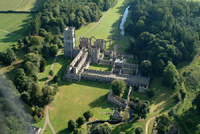 |
 |
 |
 |
 |
 |
 |
|
Fountains Abbey: History
Fountains Abbey: Buildings
|
Fountains Abbey Lands: an overview (1/33) … a
place uninhabited for all the centuries back, thick set with
thorns, lying between the slopes
of mountains
and among rocks jutting out on both sides; fit, rather, it seemed,
to be the lair of wild beasts than the home of human beings. Its
name was Skelldale. The Cistercians sought to live simply by the fruits of their own labour and not from the sweat and toil of others. Each community was designed to be self-sufficient, providing the necessary food, clothing, building materials, fuel and other requirements. Every Cistercian house therefore needed a variety of landed holdings and rights, including arable and pastoral lands, woodland, mills, fisheries and minerals. Upon its foundation, each abbey was endowed with the necessary resources. The monks had then to acquire additional lands and rights to support growth and perhaps even to finance the establishment of daughter-houses. Fountains Abbey had its origins in 1132, when a small community of monks settled in the valley of the River Skell, near Ripon. The group encountered severe difficulties and was on the point of disbanding, but the arrival of several wealthy recruits in 1135 brought a change in fortunes and set the community on a solid economic footing. Fountains acquired a vast number of lands and rights throughout the twelfth century, and at a remarkable rate. By the end of the century, Fountains had established the core of its estates, setting itself up as one of the wealthiest religious houses in the North of England and the wealthiest Cistercian abbey in the country. The community ultimately had holdings in almost 140 different vills scattered throughout Yorkshire, Lancashire, Lincolnshire and Cumbria. Whilst Fountains’ acquisition was in many ways exceptional, with other Cistercian abbeys, such as Rievaulx and Sawley, starting out on a firm footing and then encountering difficulties, its later experiences were less unique. In the late thirteenth century Fountains faced the same economic hardships that were suffered by other religious communities and, like other Cistercian abbeys, Fountains began the process of assigning the management of its estates to laymen, either as tenants or keepers of abbey demesne. In May 1538, on the eve of the Dissolution, Abbot Marmaduke Bradley began to lease out the demesne lands, probably a means to run down the community’s stock.(2) This section provides a brief chronological survey of how and where Fountains acquired its holdings, of the motives of its benefactors, and of the various kinds of lands and possessions that the community held: arable and pastoral land, woodland, and urban property; mills, fisheries and mining rights.(3) |
